Winter sun backlighting their frosted breath, a dozen people trudge gingerly in the icy waters of the Trent River in search of salmon.
Loaded with gear and armed with wooden poles, eyes down and intent, they test each step on slick rocks while navigating the currents swelled by November rains.
Each fall, upwards of 25 volunteers join an expedition to a remote section of the Vancouver Island river to help the Courtenay Fish and Game Protective Association trap spawning coho to take back to its new hatchery at Comox Lake.
It’s no easy feat. The pools and spawning beds where the coho prefer to gather are at the bottom of the river canyon’s steep slopes.
Capturing the fish alive and transporting them along the river and then up a 150-metre bluff to a waiting transport truck requires co-ordination and effort.
“It’s pretty strenuous work,” said Courtenay fish and game member Greg Sawchuck as he scrambled down the steep, muddy, rocky slope clutching a yellow nylon rope in one hand and an orange chainsaw to clear brush in the other.
“We used to put [the coho] in plastic bags filled with water and have to carry them up in backpacks.”
Volunteers with the Courtenay Fish and Game club go to great lengths to conserve wild coho from the Trent River on Vancouver Island. Video: Rochelle Baker/ Canada's National Observer
Nowadays, the precious coho travel the last leg of their monumental journey on the “salmon skyline,” a makeshift fish gondola designed by the fish and game club.
The skyline consists of a big, blue, plastic water-filled barrel suspended on a steel wire. A pulley and rope system powered by vehicles on the hilltop moves the cable car up and down the slope.
Once aboard, the system allows live salmon to soar above trees to the canyon top quickly, with as little stress possible, said Sawchuck, who directs the operation team with a walkie-talkie.
However, getting the fish up the hill is Phase 2 of the operation. The team working the river below has to catch them first, said Wayne White, the club’s conservation chairperson.
Hauling nets, ropes and specialized equipment, the catching crew wades through the river, or clambers its tangled banks, to the salmon’s favourite resting spots.
Breaking into two teams, their role is to either “flush” or “fish” the coho.
Lining up across the stream, team one begins agitating the water with poles to corral the fish towards a gill net wielded by group two — some of whom actually swim the frigid river to prevent gear from tangling or fish escaping.
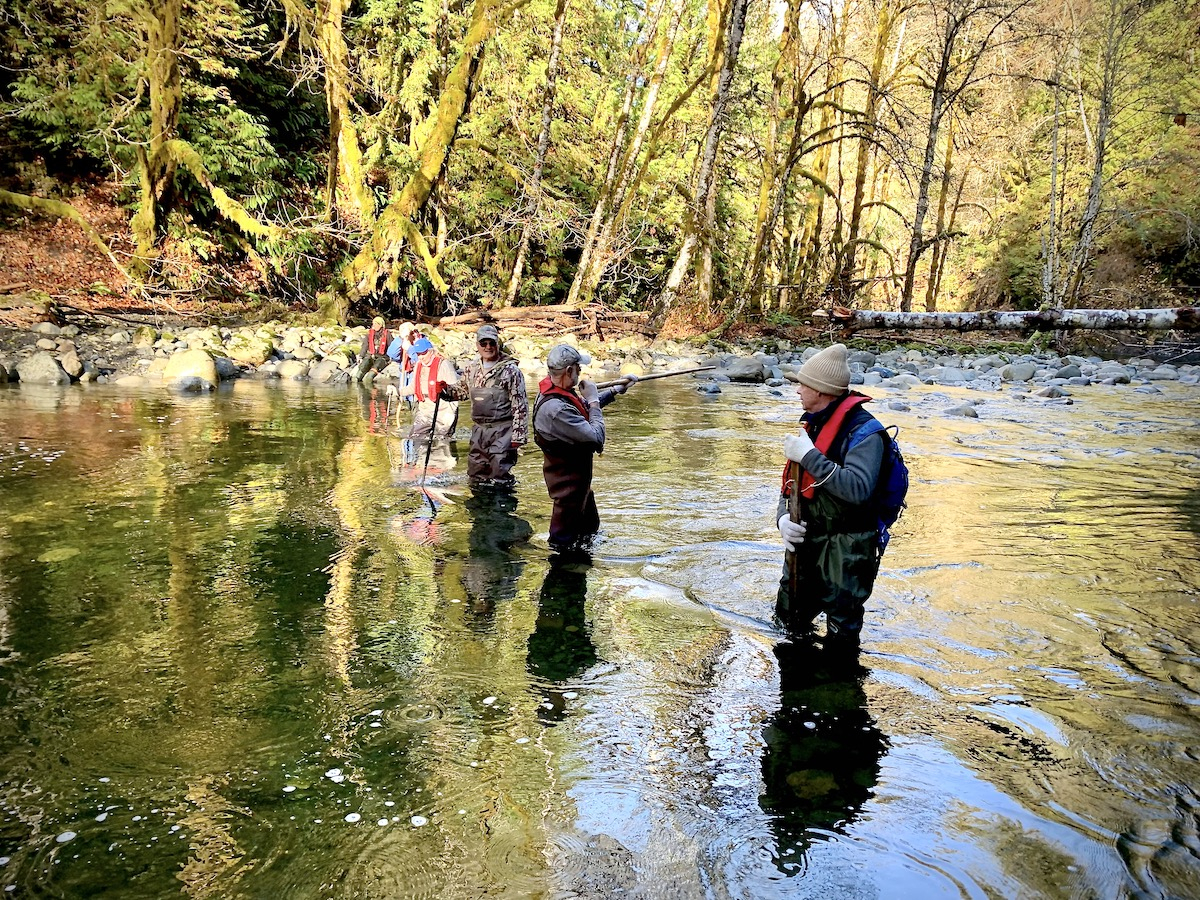
“Once the fish actually get trapped in the net, you have to get them out quickly or they’ll actually drown,” White said.
The crew pops each salmon into a recycled perforated plastic tube that is submerged in the river to provide the fish with fresh, oxygenated water.
Then someone has to drag the immersed “salmon submarines” on ropes upstream into the current to get the fish to the base terminal and tram ride to the top, White said.
“That's probably the hardest job because the rocks are slippery and there are some pretty large boulders and that type of thing,” he said.
“Once they’re at the skyline, it’s fairly easy. You just slide them into the barrel and give them a ride up the hill.”

The fish are greeted by a crew at the top of the cliff that undoes the barrel, grabs the dark-headed, scarlet-bellied fish and pops them into a steel oxygenated tank on a transport trailer. Then the barrel is sent downhill to pick up the next batch.
Once all the fish are gathered and their health assured, they begin a 45-minute road trip down bumpy logging roads before speeding along the highway to their final destination at the club’s Comox Lake property.
The fish and game club has a licence from Fisheries and Oceans Canada (DFO) to raise up to 50,000 coho salmon eggs from the Trent River to enhance recreational fisheries in the watershed, he said.
Each female salmon typically carries between 2,000 and 2,500 eggs.
The club tries to net around 60 coho annually. Attention is paid to getting the right mix of genders because the milt (semen) from two male fish is needed to fertilize one female’s eggs.
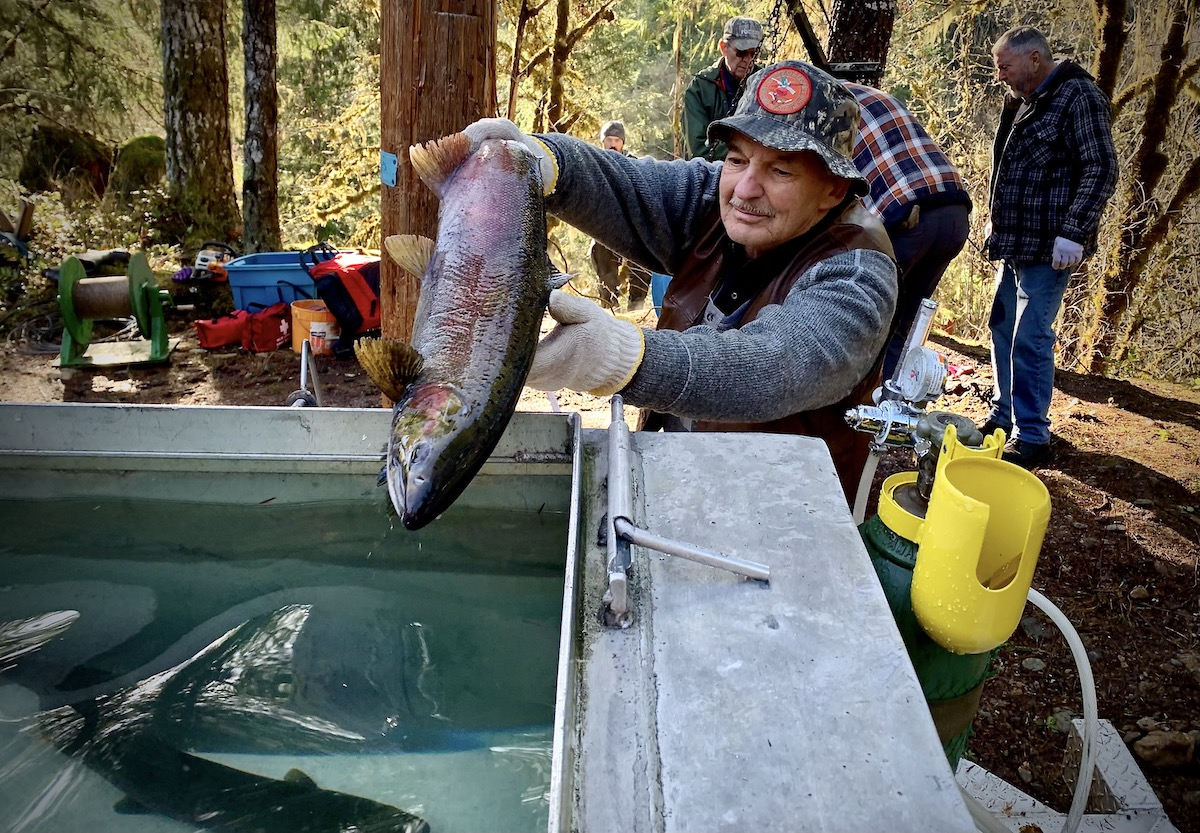
After the coho eggs are harvested and fertilized in November, they are placed in egg trays washed with running water to develop.
The first weeks are critical because the incubating eggs are especially fragile, White said.
“The first month or so, they're very, very susceptible to noise or light and it can cause them to die.”
But after that initial stage, the eggs will get purposely “shocked” by volunteers who pour them back and forth from one bucket to another to harden them up — tumbled around just as they would be by winter floodwaters in a natural river system, White said.
The coho fry usually hatch around March and are put into tanks to grow out in batches until their release in the early summer.
As soon as the little fish hit the tanks, the club’s cadre of dedicated volunteers hand-feed them twice a day and monitor their health and progress.
The fry are released high upstream in June, to keep them from competing with their wild brethren confined to the lower reaches of the river by a set of waterfalls.
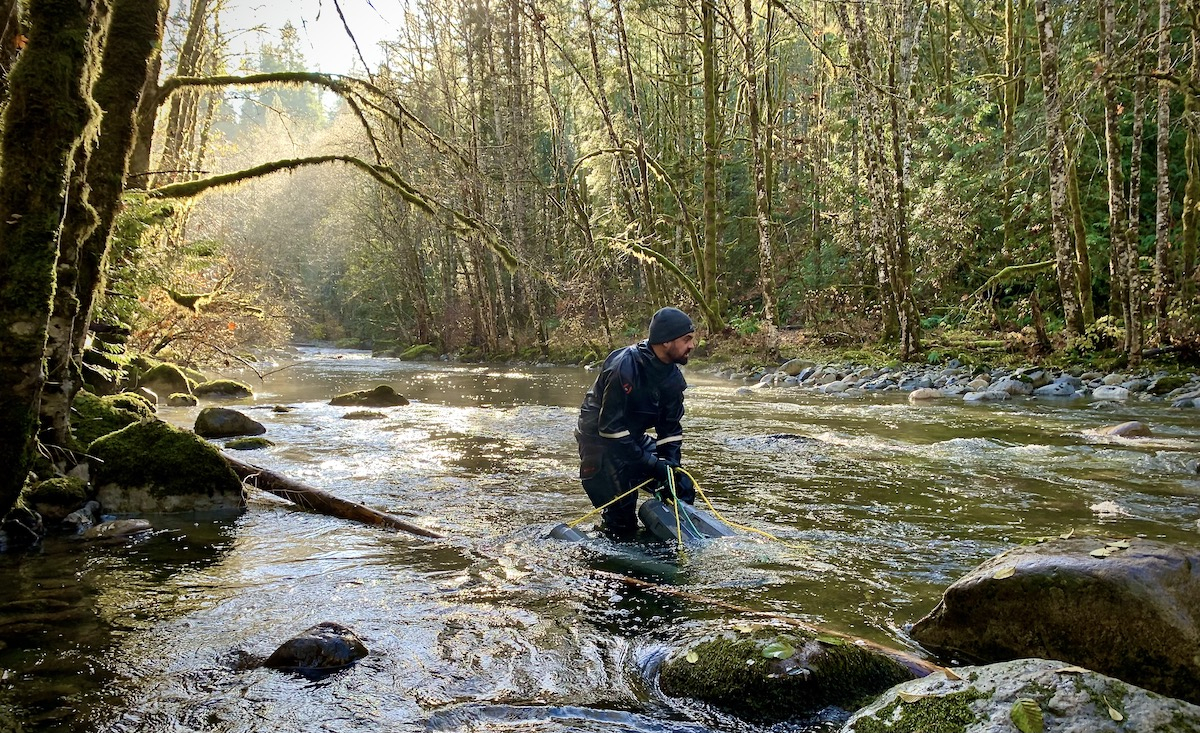
The Courtenay club has run a hatchery program on the Trent River since 1979.
The new hatchery was needed after the water quality at the old Puntledge townsite degraded. The new larger hatchery is only in its second year of operation and is a centrepiece of the conservation program, said White.
Once fully operational, the club hopes to also raise 50,000 coho for release in the Puntledge River system.
The club has a long history on the Trent River but its fish are on the decline, White said.
“If you talk to the old guys who fished it back in the day, there were a lot more coho [and] steelhead [salmon] all through the canyon.”

None of the club’s extensive conservation efforts would be possible without its dedicated volunteers, he said.
Some help because they picked up relevant skills in their work lives, but most get on board because they love to fish and are committed to preservation, White said.
“We have a lot of folks who are sports fishermen and a lot of members who are commercial fishermen who want to give back,” he said.
Some folks don’t even fish but just love salmon and help out in the hatchery, he added, noting many get attached to the brood.
“People just love to feed them, stand there and watch them.”
Rochelle Baker / Local Journalism Initiative / Canada's National Observer
I had the same question about
I had the same question about whether the river is being restored. I am also curious about whether these efforts are intended to increase salmon population (and if so how, especially if they are being culled from a wild population)
Alas, the admirable and
Alas, the admirable and dedicated members of the Courtenay Fish and Game Protective Association (CFGPA) are the victims of a longstanding fallacy, which is that hatcheries can be used to increase salmon. Hatcheries actually destroy wild salmon runs because the hatchery selection process is unnatural and the selection processes that naturally cull unfit juvenile salmon are eliminated.
Why is the hatchery fallacy so prevalent in BC? I think it is because the fallacy benefits the logging industry, which would like us to believe that riparian zones can be logged without impacting salmon.
What the CFGPA and similar organizations should be doing, in my opinion, is raising money for the purchase of property covenants in order to create larger riparian zones. Large riparian zones promote the conditions (cool water, clean gravel and large woody debris) under which salmon evolved. Of course there are many other benefits to large riparian zones, such as recreation, watershed improvement and so forth.
In the rare cases when a salmon run has been wiped out, and must be restarted, I think the best way to do it is the traditional First Nations' method, which is to transport ripe spawners from nearby streams.
Notably, there is a climate change dimension to all of the above because nitrogen is often a limiting nutrient in forests, and salmon transport nitrogen from the marine environment to the terrestrial environment. This nitrogen makes trees grow faster and larger in valleys with salmon streams, and the larger faster-growing trees sequester more carbon. Possibly (I'm speculating here, obviously) the best thing BC could do to combat global warming is to increase the riparian zones on all its salmon streams.
Sincerely,
Neil Frazer, PhD
(born and raised in the Comox Valley)

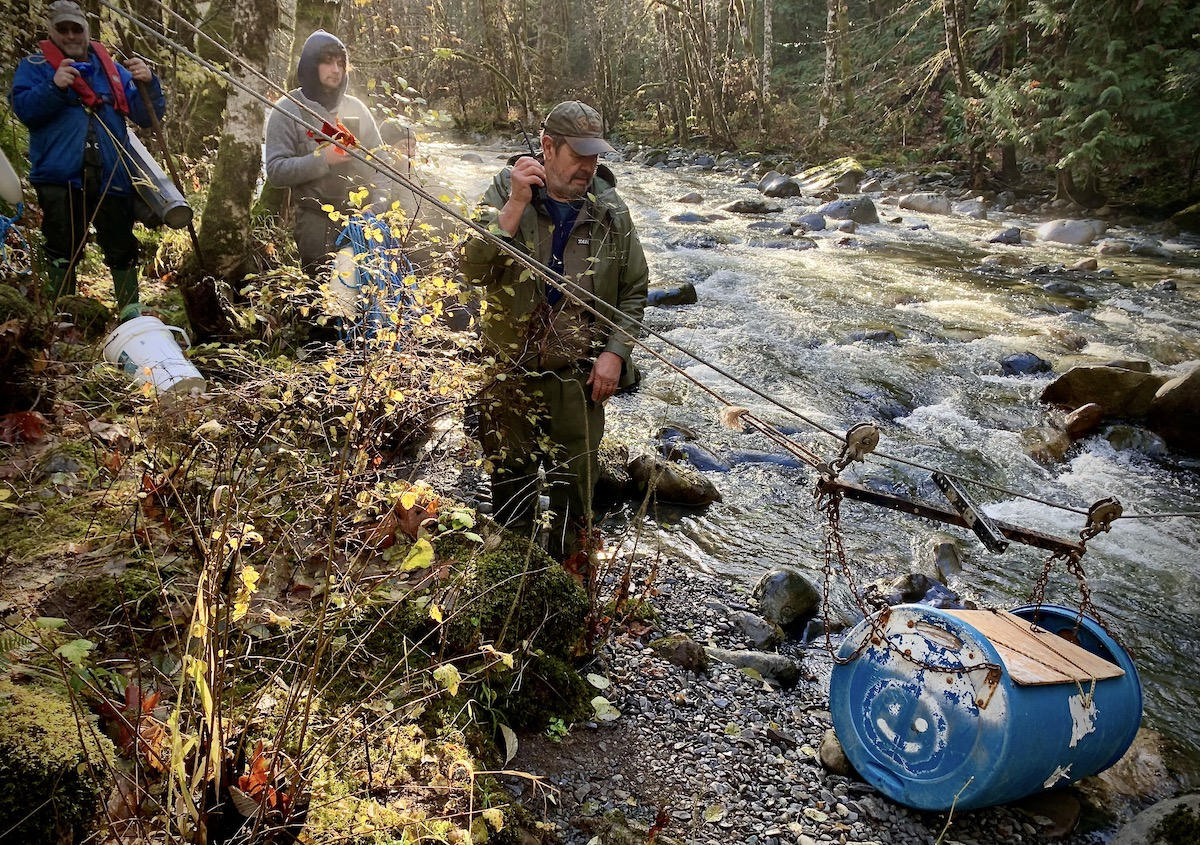


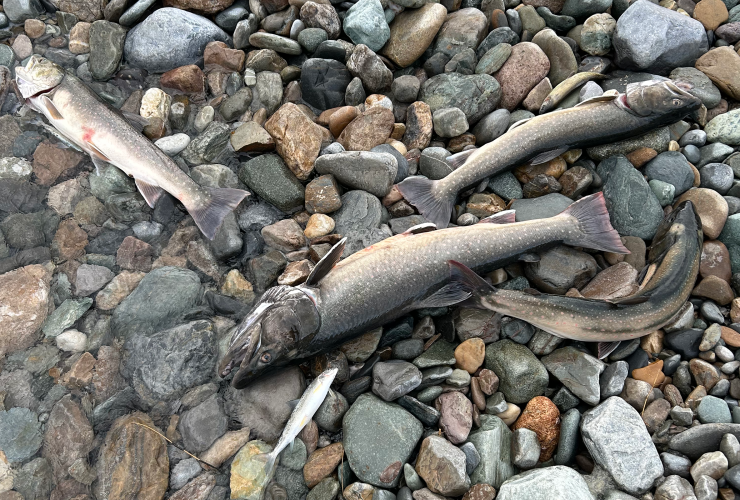

Comments